This article is reproduced from the 97th issue of “Ganoderma” magazine in 2023, published with author’s permission. All rights to this article belong to the author.
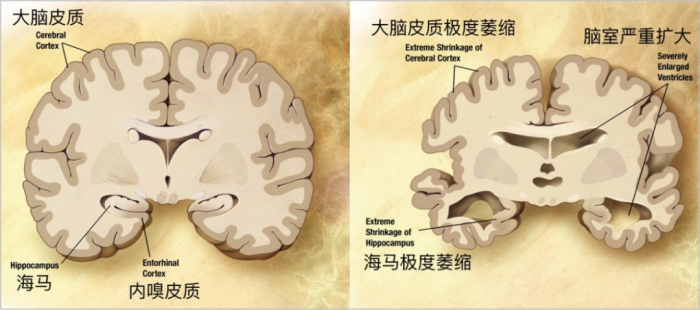
A significant difference can be observed in the brain between a healthy individual (left) and an Alzheimer’s disease patient (右).
(画像ソース: Wikimedia Commons)
Alzheimer’s disease (広告), commonly known as senile dementia, is a progressive neurodegenerative disorder characterized by age-related cognitive impairment and memory loss. With the increase in human lifespan and population aging, the prevalence of Alzheimer’s disease is steadily rising, posing a significant burden on families and society. したがって, exploring multiple approaches to prevent and treat Alzheimer’s disease has become a topic of great research interest.
In my article titled “Exploring the Research on 霊芝 for Preventing and Treating Alzheimer’s Disease,” published in the 83rd issue of “Ganoderma” magazine in 2019, I introduced the pathogenesis of Alzheimer’s disease and the pharmacological effects of マンネンタケ in preventing and treating Alzheimer’s disease. Specifically, マンネンタケ 抜粋, マンネンタケ 多糖類, マンネンタケ トリテルペン, そして マンネンタケ spore powder were found to improve learning and memory impairments in Alzheimer’s disease rat models. These components also exhibited protective effects against degenerative neuropathological changes in the hippocampal brain tissue of the Alzheimer’s disease rat models, reduced neuroinflammation in brain tissues, increased the activity of superoxide dismutase (SOD) in the hippocampal brain tissue, decreased the levels of malondialdehyde (MDA) as an oxidative product, and demonstrated preventive and therapeutic effects in experimental animal models of Alzheimer’s disease.
The two preliminary clinical studies on マンネンタケ for preventing and treating Alzheimer’s disease, introduced in the article, have not definitively confirmed the effectiveness of マンネンタケ in Alzheimer’s disease. しかし, combined with numerous promising pharmacological research findings, they provide hope for further clinical studies.
The effect of usingマンネンタケ spore powder alone to treat Alzheimer’s disease is not obvious.
Reviewing the research paper titled “Spore powder of マンネンタケ for the treatment of Alzheimer’s disease: A pilot study” published in the journal “Medicine” [1], the authors randomly divided 42 patients who met the diagnostic criteria for Alzheimer’s disease into an experimental group and a control group, と 21 patients in each group. The experimental group received oral administration of マンネンタケ spore powder capsules (SPGL group) の用量で 4 カプセル (250 mg each capsule) three times a day while the control group only received placebo capsules. Both groups underwent a 6-week treatment.
At the end of the treatment, compared to the control group, the SPGL group showed a reduction in scores for the Alzheimer’s Disease Assessment Scale-Cognitive Subscale (ADAS-cog) and the Neuropsychiatric Inventory (NPI), indicating an improvement in cognitive and behavioral impairments, but the differences were not statistically significant (テーブル 1). The World Health Organization Quality of Life-BREF (WHOQOL-BREF) questionnaire showed an increase in life quality scores, indicating an improvement in life quality, but again, the differences were not statistically significant (テーブル 2). Both groups experienced mild adverse reactions, with no significant differences.
The authors of the paper believe that the treatment of Alzheimer’s disease with マンネンタケ spore powder capsules for 6 weeks did not show significant therapeutic effects, possibly due to the short duration of treatment. Future clinical trials with large sample sizes and longer treatment durations are needed to gain a clearer understanding of the clinical efficacy of マンネンタケ spore powder capsules in the treatment of Alzheimer’s disease.

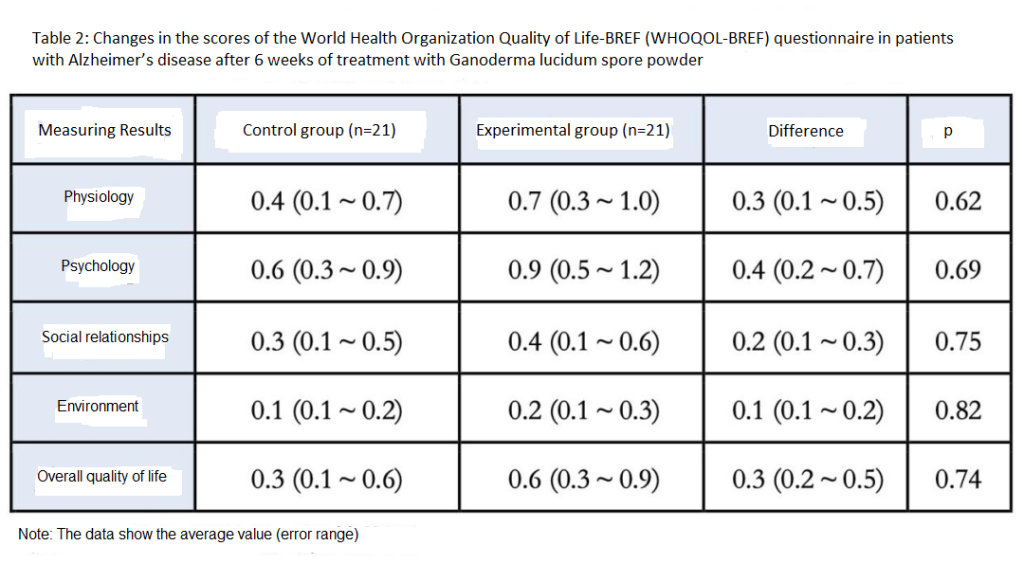
The combined use ofマンネンタケ spore powder with conventional treatment drugs significantly improves the therapeutic efficacy in treating Alzheimer’s disease.
最近, a study evaluated the combined effects of マンネンタケ 軽度から中等度のアルツハイマー病患者の認知力と生活の質に対する胞子粉末とアルツハイマー病治療薬メマンチン [2]. 48人の患者がアルツハイマー病と診断された, 老人 50 に 86 years, ランダムに対照群と実験群に分けた, と 24 patients in each group (n=24).
治療前, 性別に関して2つのグループ間に統計的に有意な差はありませんでした, 認知症の程度, ADAS-cog, NPI, およびWHOQOL-BREFスコア (P>0.5). 対照群には、次の用量のメマンチンカプセルが投与されました。 10 mg, 1日2回, 一方、実験グループには同じ用量のメマンチンと マンネンタケ spore powder capsules (SPGL) の用量で 1000 mg, 1日3回. 両グループとも以下の治療を受けました 6 週, 患者の基本データが記録されています. 患者の認知機能と生活の質は、ADAS-cog を使用して評価されました。, NPI, and WHOQOL-BREF scoring scales.
治療後, both groups of patients showed a significant reduction in ADAS-cog and NPI scores compared to before treatment. さらに, the experimental group had significantly lower ADAS-cog and NPI scores than the control group, with statistically significant differences (P<0.05) (テーブル 3, テーブル 4). Following treatment, both groups of patients demonstrated a significant increase in scores for physiology, psychology, social relationships, 環境, and overall quality of life in the WHOQOL-BREF questionnaire compared to before treatment. Moreover, the experimental group had significantly higher WHOQOL-BREF scores than the control group, with statistically significant differences (P<0.05) (テーブル 5).
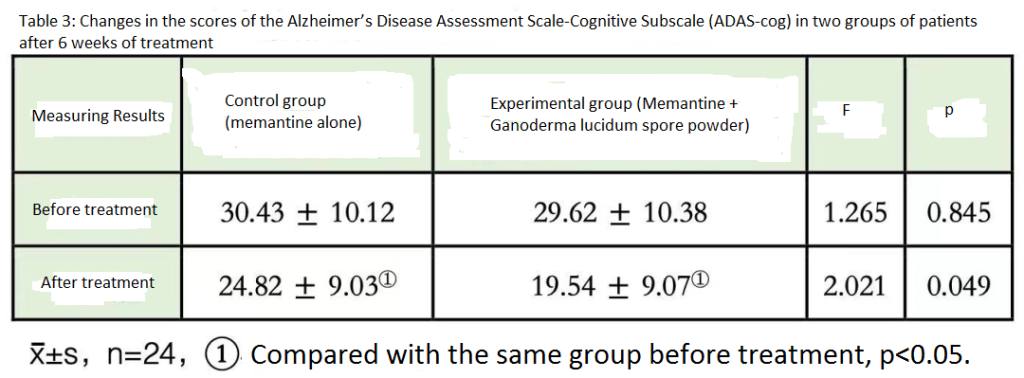
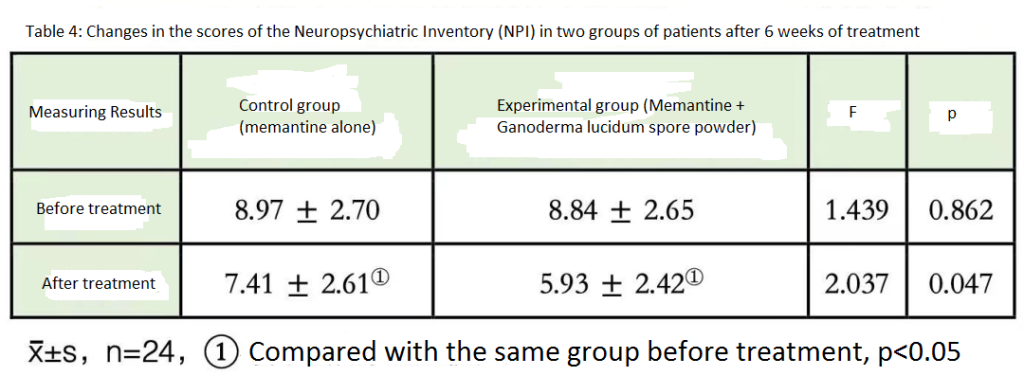
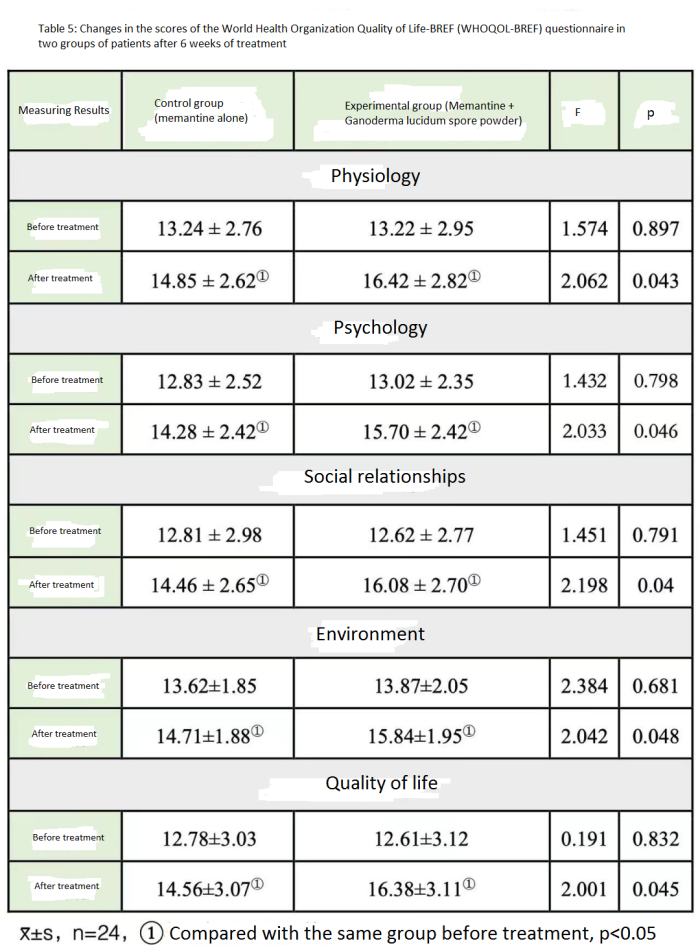
Memantine, known as a novel N-methyl-D-aspartate (NMDA) receptor antagonist, can non-competitively block NMDA receptors, thereby reducing glutamic acid-induced NMDA receptor overexcitation and preventing cell apoptosis. 認知機能を改善します, 行動障害, 日常生活の活動, アルツハイマー病患者の認知症重症度. 軽度の治療に使用されます, 適度, そして重度のアルツハイマー病. しかし, この薬を単独で使用しても、アルツハイマー病患者に対する効果はまだ限られています.
この研究の結果は、以下を組み合わせて適用すると、 マンネンタケ 胞子粉末とメマンチンは、患者の行動能力と認知能力を強化し、生活の質を大幅に向上させることができます.
アルツハイマー病の治療には、適切な投薬アプローチを選択することが重要です.
上記の 2 つのランダム化比較臨床試験では、 マンネンタケ アルツハイマー病治療用の胞子粉末, ケースの選択, 診断, 霊芝胞子粉末の供給源, 投与量, 治療の経過, 有効性評価指標は同一であった, しかし臨床効果は異なりました. 統計分析後, の使用 マンネンタケ アルツハイマー病を治療するための胞子粉末単独では、AS-cog の有意な改善は示されなかった, NPI, プラセボと比較したWHOQOL-BREFスコア; しかし, の併用 マンネンタケ 胞子粉末とメマンチンは、メマンチン単独と比較して 3 つのスコアで大幅な改善を示しました, つまり, の併用 マンネンタケ 胞子粉末とメマンチンは行動能力を大幅に向上させることができます, アルツハイマー病患者の認知能力と生活の質.
現在, アルツハイマー病の治療に使用される薬, ドネペジルなど, リバスチグミン, メマンチン, そしてガランタミン (レミニール), 治療効果は限られており、症状を軽減し、病気の経過を遅らせることしかできません。. 加えて, 過去にアルツハイマー病治療のための新薬の開発に成功した例はほとんどない 20 years. したがって, の使用マンネンタケ アルツハイマー病の治療薬の効果を高める胞子粉末に注目する必要がある.
今後の臨床試験については、 マンネンタケ 胞子粉末のみ, 投与量を増やすことを検討することも可能かもしれません, 例えば, 2000 毎回mg, 1日2回, 少なくとも一定のコースでは 12 週. これが実現可能かどうか, この分野の研究結果が答えを教えてくれるのを楽しみにしています.
[参考文献]
1. 王國輝, 他. の胞子粉マンネンタケ アルツハイマー病の治療用: パイロット研究. 医学(ボルチモア). 2018;97(19): e0636.
2. 王立超, 他. メマンチンの効果と合わせてマンネンタケ アルツハイマー病患者の認知力と生活の質に関する胞子粉末. 武装警察医科大学ジャーナル (医療編). 2019, 28(12): 18-21.
林志斌教授の紹介

氏. 林志斌, の先駆者 霊芝 中国での研究, この分野にほぼ半世紀を捧げてきた. 彼は北京医科大学でいくつかの役職を歴任しました, 副社長も含めて, 基礎医学系副学部長, 基礎医科学研究所所長, 薬学部長. 彼は現在、北京大学基礎医科学部薬理学科の教授を務めています。. から 1983 に 1984, 彼はイリノイ大学シカゴ校のWHO伝統医学研究センターの客員研究員でした。. から 2000 に 2002, 彼は香港大学の客員教授でした. 以来 2006, 彼はロシアのペルミ州製薬アカデミーの名誉教授を務めています。.
以来 1970, 彼は現代の科学的手法を用いて、伝統的な中国医学の薬理学的効果とメカニズムを研究してきました。 霊芝 とその有効成分. 彼は霊芝に関する 100 以上の研究論文を発表しています。. から 2014 に 2019, 彼はエルゼビアの中国で最も引用された研究者リストに 6 年連続で選ばれました。.
彼は霊芝に関する多くの本を書いています, 「霊芝に関する現代研究」を含む(1第 1 ~ 4 版), 「霊志からミステリーへ」(1第 1 ~ 3 版), 「霊芝は健康的なエネルギーをサポートし、病原性因子を追い出します」, 腫瘍の治療を助ける」, 「霊芝についての議論」, そして「霊芝と健康」.



